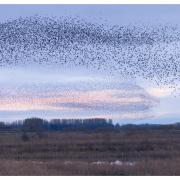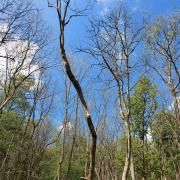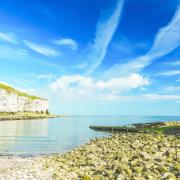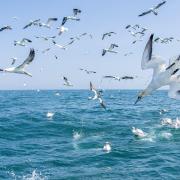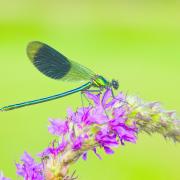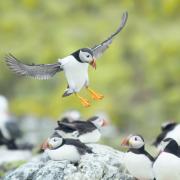Tom Marshall from the Yorkshire Nature Triangle explores what the future holds for Spurn Point, an iconic landscape which is constantly at the mercy of the elements

Take your pick of Land’s End or John O’ Groats and whichever you choose you’d say you’ve been to the end of Great Britain. But can you go to the end of Yorkshire? With its windswept marram-covered sand dunes, big skies, long beaches and occasional exotic wildlife, Spurn Point often feels like just such a spot.
Just an hour east of Hull, Spurn really is about as far as you can go in Yorkshire, and this fascinating wilderness-like area which adorns so many geography text books belies a rich natural and cultural history that is still changing today, as nature gives, shapes and in some cases takes away from this iconic peninsula.
The characteristic ‘spit’ of Spurn has been formed over more than 10,000 years as sand – often eroded after storms further north in Holderness – has been gradually pushed further south by wave and tide action or ‘longshore drift’, ultimately depositing to create the three mile long system of dunes seen today.
This ever-changing environment has created a unique feature of the East Yorkshire map that has kept Britain’s cartographers busy for centuries. The first major settlers made a home here in the 14th century, at the medieval port of ‘Ravenspur’, which – like many Holderness villages of latter generations – eventually succumbed to the sea. The first ‘modern’ residents were the lifeboatmen of the early 1800s, who, along with their families also made a home alongside their vessels.

It was however two world wars and a growing global shipping industry that firmly cemented Spurn’s place in the history books, as gun emplacements sat alongside lighthouses and eventually holiday homes and modern day radar systems, all of course taking advantage of an unparalleled location at the mouth of the estuary.
Perhaps inevitably, the opportunity that nature had offered to countless military chiefs, shipping captains and holiday makers, it also took away in a matter of hours in December 2013 when a North Sea storm surge ripped through Spurn, leaving a 150 metre gap in the spit – and creating one of Britain’s newest islands.
The effects of those few devastating hours were felt no more keenly than by the Yorkshire Wildlife Trust, who had looked after the Spurn National Nature Reserve since 1959 and now found themselves with a site effectively cut in two by the sea. After just one night, the RNLI, the port authority and the Trust suddenly found themselves as islanders, with the impact felt just as keenly in the nearby village of Kilnsea, which was also left under water.
A year and a half on from that night and despite the immense challenges, a new chapter in the Spurn story is in the making, with Mother Nature once again at the heart of the action.

Visit Spurn today, and the beachside vista that once saw the sails of tall ships bound for the four corners of the globe has been replaced by the precision designed sails of the most modern of wind farms – harvesting the wind to power more than 150,000 homes in East Yorkshire.
Constructed by energy company E.ON, the Humber Gateway is one of Britain’s newest wind power generating locations, and it’s this 21st century addition to the seas to the north of Spurn that will now provide a new backdrop. With similar coastal wind power projects elsewhere in the UK attracting more than 40,000 visitors a year, it’s hoped that the Humber Gateway could be the next phase in Spurn’s ongoing relationship between people and the elements.
Whatever the weather has thrown at Spurn, one constant throughout all of this change has been the area’s wildlife. No doubt from those first days of Ravenspur, Spurn has been a vital location for the in-built sav nav of migratory birds. With such a prominent position on the east coast, it’s no surprise that Spurn has been home to a bird observatory since the 1940s and to this day it remains one of the most visited locations – for both birds and bird-watchers alike.
Alongside rare breeding species like little terns, Spurn remains a hotspot for thousands-strong flocks of autumn and winter wading birds and wildfowl, and rarities that have found themselves blown off course. As a key landmark for arriving migratory species, a single day at Spurn can see birds like swallows being counted at more than 15,000, while a single wryneck, or tropical-looking hoopoe, bee eater or shrike can bring just as much excitement for wildlife lovers. The seas off Spurn can certainly deliver too, with a humpback whale just one highlight in recent years.

Being such a popular destination has created a unique challenge for nature reserve managers the Yorkshire Wildlife Trust, who over the last 50 years have battled to balance the needs of visitors with maintaining the remoteness and delicate wildlife habitats of Spurn. The effects of the 2013 storm surge also added to this, creating additional dangers for visitors wanting to explore the newly created island.
With so much at stake for the future of Spurn, plans have been drawn up to help deliver a new exciting experience at Yorkshire’s ‘end of the world’. As part of the Trust’s ground-breaking Yorkshire Nature Triangle initiative, which promotes wildlife-watching destinations across East Yorkshire, a series of new projects are taking shape.
Combined with 4x4 ‘safaris’ across the wash-over at the heart of Spurn, the Matthews Lighthouse will once again be seen in all its glory as it begins a new life – including a chance for visitors to enjoy the view from the top – more than 30 years since its doors last closed.
The biggest opportunity for Spurn however, is likely to come from a new £900,000 visitor centre proposed near Kilnsea, supported by E.ON as part of the Humber Gateway project. This innovative facility will combine state-of-the-art construction – allowing the centre to withstand storms and even move to a new location in the future – with an inspiring place for visitors, schoolchildren and a new home for RNLI Lifeboats equipment and the port authority’s radar systems.

The centre will also complement other recent developments at RSPB Bempton Cliffs, Yorkshire Wildlife Trust’s Living Seas Centre at Flamborough and proposals for Yorkshire Water’s Tophill Low – all combining to help drive a 20% annual growth in nature-based tourism.
Following in the footsteps of those early settlers at Ravenspur, the lifeboatmen and the military, the Trust believes Spurn’s newest addition will have a dual impact of supporting local businesses, while also allowing visitors to the site to be well informed and safe, helping to protect wildlife and the habitats that make the area so special.
After all that has been thrown at it, Spurn has remained resilient and will no doubt continue to fascinate visitors from Yorkshire and beyond for years to come.
Visiting Spurn
Take the A1033 from Hull or the B1242 from Hornsea before joining the B1445 to Easington and Kilnsea.
There is a small charge for car parking and to take the daily Unimog 4x4 ‘Spurn Safari’ across the storm breach to the end of Spurn Point. There is no other vehicle access across the storm breach.
Matthews Lighthouse will re-open in autumn 2015 as a brand new visitor experience. To find out more about the plans for the future of Spurn visit www.ywt.org.uk.












